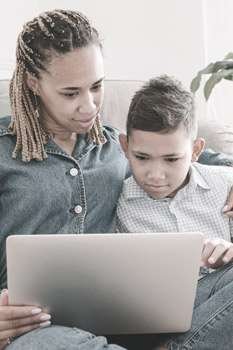Kids today are smarter than ever before, but they often lack the opportunity to learn about coding. Coding is a valuable skill that will provide them with endless opportunities for employment in the future. This blog post provides you with some resources and strategies for teaching kids how to code!
What is coding?

The first step is to teach kids what coding is and why they should learn it. Coding involves writing instructions for a computer to follow, not unlike reading or math skills.
Coding is essentially a language that allows you to create digital products and programs. It comes in many forms, but the most common form of coding for young kids is called “block” coding or visual programming.
With this type of coding, users snap-together blocks that represent commands they want their program to complete. For older kids, there are other types of coding they can learn, like text-based coding.
Text-Based Coding vs. Block Coding
There is some debate in the education community about which type of programming kids should be taught first — block or text-based!
Many educators believe that young children develop conceptual understanding best when working with concrete materials; therefore, it’s better to teach them to block coding before moving on to more complex forms of code.
Others argue that since most modern devices require users to type commands into a computer rather than build blocks on a screen, students need exposure to both approaches from an early age so that they can succeed in this new technological world.
In reality, you don’t have to pick just one method for teaching programming concepts to kids. You can teach them both!
Block-based coding software is designed for younger students, while text-based code is more suitable for older children and adults. This means you have the flexibility to use a program that best meets your child’s developmental needs at any age or grade level.
Why should kids learn to code?
Learning these types of skills will provide endless opportunities in the future as technology advances!
Coding is also a special skill that can help kids excel in school or secure a spot at an excellent job later on. Code is the language of all modern programming, and it’s quickly becoming one of the most sought-after skills out there!
It’s important to note that coding isn’t just limited to computer science — teaching your child how to code will prepare them for many types of careers. This includes traditional areas like IT and non-traditional fields such as marketing and business analysis (which often involve working with computers). Teaching your child about coding early gives them a leg up over their peers when they enter the workforce!
Coding is the new literacy, and it’s an incredibly valuable skill for any student or professional looking to excel in today’s world! It teaches logic, problem-solving skills, critical thinking, communication abilities, attention span, creativity, and more.
There has never been a better time than now to learn how to code! And with so many resources available, there isn’t an excuse not to get started right away!
How to teach kids the basics of coding.
Now that you know why your child should learn to code, it’s time to start! There are many ways for kids of all ages and backgrounds to begin learning about the basics of programming.
First off, encourage them to play games that teach code. Many websites offer free or paid options for fun math-based activities that help students learn basic coding concepts without even realizing anything is being taught at first!
For a younger audience, try looking into apps like Hopscotch or Tynker. Both have excellent resources available from an early age. These types of programs make learning to program fun while bridging the gap between education and entertainment. In addition, they provide helpful visualizations, so your child can easily recognize what’s going on.
For a slightly older audience, like teens, try looking into websites like Coda Kid or Code Avengers. These websites offer a range of options for young adults, and all courses have a free trial, so you can see if your child enjoys it before committing to a subscription! These websites also offer helpful visualizations and guides, so kids of any age or background should find these resources manageable.

Computer science classes at school are another fantastic option for learning the basics of coding.
Even though not all schools have this type of program accessible to their students, they are still a great way to get started. If your school doesn’t have this program, encourage them to learn about it and suggest starting one next year!
Parents who would like to do more formalized lessons with their children at home should use traditional books or online tutorials to teach them the basics. Many resources are available, from beginner’s guides to full-fledged coding programs that can help kids build upon skills they’ve already learned in previous lessons.
Finally, there are online courses that offer more in-depth learning opportunities for coding basics. Many companies now offer free or paid options for students eager to develop their skills further!
Khan Academy is an excellent example of this — they provide free tutorials on many programming languages, including JavaScript, which most websites use today. They also host challenges where kids can test out what they’ve learned by building projects like games.
Codeacademy is another great resource for learning to code. They provide free options, but more in-depth courses are also available through paid subscriptions on their website.
In addition to these resources available online, there are also many great programs to teach kids coding with the bonus of providing them with some fun physical gadgets.
This includes options like Raspberry Pi and Arduino, which introduce children to hardware programming while giving them something tangible they can regularly use after the learning process is over!
If you prefer an old-fashioned option that requires taking your child out somewhere, look into local programs offered by libraries or community centers near your area.
There may be options available for younger students and teenagers who would benefit from more advanced courses! It might take some time to find something perfect located nearby, but it is definitely worth the effort compared to online education.
Places like Code Ninjas provide kids with another fun way to learn how to code. They offer a range of programs for children, including full-day camps and after-school classes taught by qualified instructors who work in the tech industry!
Set up a space that’s conducive to learning.
It can be challenging for children (and adults!) to stay focused on the task at hand if they’re not comfortable.
Even if your child is comfortable sitting at a desk, it’s still nice to give them the option of moving around. If you have room in their bedroom or playroom for an activity table with chairs attached, this can make coding classes more fun!
Teaching kids how to code can be a lot of fun! You might even find yourself enjoying it too! There are many ways you can do this, and make sure it’s something both you and your children enjoy doing together.
Start by setting up a space where everyone feels comfortable playing around writing their computer programs or exploring different programming languages.
It’s essential to have a fun and functional space since you’ll spend a lot of time in this area together.
Make sure everyone involved knows they are allowed to make mistakes! Coding isn’t something where there is one correct answer. It includes many problems with unique solutions, so it can take some trial and error before kids get the hang of it.
Remember not to expect too much from your child, either. Coding is a lengthy process that can take months or even years to master, so you should only push them as far as they feel comfortable going.
If you’re confused about what happens when something doesn’t work on the computer screen, chances are they will be too! Be patient with them; iterating through possible problem-solving methods takes time if no one has done these things before.
Don’t forget to have fun together! Coding can be a valuable skill to learn, so create an inviting space for everyone involved and enjoy the process as you go along.
Set clear goals and expectations.
Before you get started teaching kids how to code, it’s essential to talk with them about what they want from this experience!
If your child is interested in learning for fun or because they hope it’ll help their future career opportunities, make sure everyone involved knows why you’re starting on the journey of coding together.
Be careful not to set unachievable goals that will only discourage both yourself and your little one — no one wants a negative learning environment! Start small if needed while encouraging continued interest along the way.
Keep in mind that most children won’t master coding overnight; continue working towards these larger goals by taking things step-by-step instead of expecting everything at once.
You should also set clear expectations for yourself as a parent. It can be easy to get frustrated with your child when they do not understand concepts right away, but try to remain calm and patient instead of getting upset or agitated!
If you need help thinking about these goals, talk it over with the other adults involved in your child’s life, so everyone is on the same page. This will make things much more manageable once classes begin!
Have fun with it!
Coding classes can be a lot of work, so don’t forget to take some time and play around with your child as well!
It’s crucial to find the right balance between work and play; both you and your little one will be more interested in coding if it feels like a fun challenge instead of an endless chore.
If they enjoy games or puzzles, ensure there is always some way to recreate their love of these things by writing computer programs together.
Don’t forget about working as a team, either; try pairing up for some programming activities so everyone has an opportunity to brainstorm ideas and work towards achieving class goals.
Allow for trial and error.

While it’s important to teach kids coding basics, you also want them to learn from their mistakes along the way!
If your child isn’t getting something right away, let them know that this is okay — everyone has trouble learning new concepts at first.
Encourage trying again with an open mind about what will happen next time instead of giving up immediately.
You can even do some research together online or ask other adults if they have any advice on approaching a problem differently!
Coding doesn’t work like math class, where there are “right” answers; sometimes, there are multiple possible solutions to one issue, so be sure not to discourage children when things don’t go as planned right away.
It will take time to learn how to code, so allow for some trial and error while encouraging creativity along the way!
Never give up!
Even though coding can be frustrating at times, it’s important to remember that everyone is on this journey together. Parents and children alike should never give up when learning how to code — there are always new challenges around the corner for both of you!
As long as you keep meeting these challenges head-on with an open mind about what will happen next time around, there won’t ever be a reason why anyone needs to stop trying again.
Remember that everything builds on itself; just because your child didn’t understand something today doesn’t mean they’ll have trouble grasping another concept later on down the line after gaining more experience along the way. Coding will become easier over time if they continue taking things step-by-step instead of expecting everything all at once.
Remember that you can’t expect everyone to love coding right away.
It’s okay if your child isn’t interested in computer programming right away!
Everyone learns at their own pace, so don’t worry about what anyone else is or isn’t doing. Just because your child hasn’t taken an interest in coding yet doesn’t mean they never will; it just means that they might need more time to explore this new subject on their own terms instead of feeling pressure from outside sources when trying something for the first time.

Remember, you can always go back and try again if needed while encouraging continued interest along the way. You should also set clear expectations for yourself as a parent — remember that things won’t work out overnight, but with small steps forward every day towards larger goals, both you and your little one will be able to succeed together someday soon!
If you’re looking for a way to get your little one excited about coding, sit down together and go online to search for different games or activities.
Not only will this allow you to bond with them while having fun, but it’s also a great chance to see something through their eyes to understand how they think when approaching new challenges!
Finding the right balance between work and play is important here; make sure both of you are taking time away from learning computer programming basics for everyone not to lose interest too quickly along the way. Letting things build up over time until larger goals can be achieved makes sense because then kids won’t feel discouraged by small mistakes that could have been avoided given more practice beforehand! There should always be room for improvement while also ensuring that everyone knows it’s okay to take time off from learning how to code when needed.
Provide encouragement and praise for their success!
Remember that you’re an adult, so it’s essential to support your child no matter what.
Computer programming can sometimes feel overwhelming or frustrating, even for adults. There are so many rules and different ways things could go wrong when writing code; how much more difficult must this subject seem when learning about coding basics at such a young age?
Instead of feeling discouraged along with them, make sure to provide lots of praise and encouragement to keep their spirits high! If they succeed in completing something small like making their letter ‘a’ appear on the screen instead of an incorrect symbol (like the number ‘5’), let them know how great it is that they tried hard despite any setbacks or difficulties. This will help reinforce positive behavior for future learning sessions since everyone likes to know that they’re doing a good job.
Conclusion.
It’s never too early to start teaching kids the basics of coding. Start with simple concepts and work your way up from there to keep things fun while also not overwhelming them at the same time.
Remember that every child learns differently, so just because one child is excited about learning how to code doesn’t mean everyone will feel the same!
We hope this post helped you better understand why and when your children should start learning computer programming skills.
Comment below if there is anything else you would like us to cover in future posts on this topic!

Meet Brenda Tillman: your go-to expert in Cognitive Behavioral Therapy! Not only is she a seasoned therapist, but she’s also a passionate mom blogger who never misses a beat. Dive deep into her insightful blogs, backed by her extensive coursework in Parenting Skills, Learning, and Education. Brenda’s heartwarming family – a son, two daughters, and their adorable pets – often take center stage in her writings. From parenting hacks and relationship tips to health & fitness nuggets, Brenda has been enlightening her readers for over half a decade. Stick around, and you’re bound to discover gems from a mom who wears many hats with grace!
Reviewed By: Joanna Perez and Marcella Raskin
Edited By: Lenny Terra
Fact Checked By: Gabrielle J. Smith
Photos Taken or Curated By: Matthew Mansour